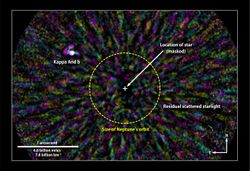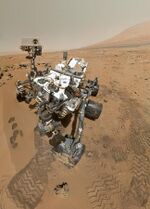Astronomy:Kappa Andromedae b
 Kappa Andromedae b is visible as the white blob in the upper left. | |
| Orbital characteristics | |
|---|---|
| 57–133[1]AU | |
| Eccentricity | 0.69–0.85[1] |
| Orbital period | 242–900[1] y |
| Inclination | 114.9–140[1] |
| Longitude of ascending node | 60.3–90.5[1] |
| astron|astron|helion}} | 2038.4–2047.9[1] |
| 96.6–155.4[1] | |
| Star | Kappa Andromedae |
| Physical characteristics | |
| Mean radius | 1.57 |♃|J}}}}}} |
| Mass | 13+12 −2[2] |♃|J}}}}}} |
| Physics | 1,700–2,000 K[2][3] |
Kappa Andromedae b[4] is a directly imaged substellar object and likely superjovian-mass planet orbiting Kappa Andromedae, a young B9IV star in the Andromeda constellation, about 170 light-years away.[5] The companion's mass is roughly 13 times the mass of Jupiter.[2] As early history on Kappa And b is filled with debate over whether it is an exoplanet or a brown dwarf, some scientists have broadly described it as a "super-Jupiter" object.
Discovery
Kappa Andromedae b was discovered through near-infrared high-contrast imaging during the Strategic Explorations of Exoplanets and Disks with Subaru (SEEDS) survey at the Subaru Telescope, located atop Mauna Kea, Hawaii.[6] Follow-up Subaru observations taken between January and July 2012 and covering a wider wavelength range confirmed that Kappa Andromedae is gravitationally bound (not a background star) and had infrared colors consistent with a substellar (possibly planet–mass) companion.[6]
Atmosphere and orbital properties
The low resolution near-infrared spectrum of Kappa And b, obtained by extreme adaptive optics system SCExAO with the CHARIS integral field spectrograph, is shaped by broad water and carbon monoxide absorption features.[2] Moderate resolution Keck/OSIRIS spectroscopy resolve these lines.[7] Based on comparisons to large libraries of spectra for other substellar objects, the companion likely has a spectral type of L0-L1: its sharp H-band (1.65 microns) shape is indicative of low surface gravity.[1][2]
Empirical comparisons to well-characterized substellar objects suggest an effective temperature of 1,700–2,000 K.[2] Atmospheric modeling incorporating longer wavelength data favors the cooler end of this temperature range, while temperatures derived from Keck/OSIRIS spectra favor higher values of 1,950–2,100 K.[7] The atmosphere of Kappa And b is likely filled by thick cloud deck extending to low atmospheric pressures.[1][3] Analysis of the companion's spectrum yields a near-solar carbon-to-oxygen ratio (C/O ~ 0.70).[7]
Kappa Andromedae b was first imaged at a projected separation of about 55 astronomical unit|AU; subsequent data sets recover the companion at smaller angular separations.[1] While only a small portion of the companion's orbital phase has been covered,[8] current limits suggest a semimajor axis likely greater than 75 AU.[2] Its eccentricity is fairly high (e ~ 0.7 or greater).[1] The relative radial-velocity between it and its host star is −1.4 +/− 0.9 km/s.[7]
System age and mass
The masses of directly imaged substellar objects (exoplanets and brown dwarfs) are usually not directly measured but are instead inferred by comparing their luminosities to predicted values for substellar evolution models. Thus, uncertainties in the system age translate into uncertainties in the object's mass. The discovery paper for Kappa Andromedae b[4] argued that the primary's kinematics are consistent with membership in the Columba association, which would imply a system age of 20 to 50 million years and a mass of about 12.8 Jupiter masses. These results were later questioned[9][10] by those who argued that the primary star's position on the Hertzsprung–Russell diagram favors a much older age of 220 ± 100 million years, provided that the star, Kappa Andromedae A, is not a fast rotator viewed pole-on. Direct measurements of the star later showed that Kappa Andromedae A is in fact a rapid rotator viewed pole-on[11] and yield a best-estimated age of 47+27−40 million years favoring a mass between 13 and 30 jovian masses. A revised luminosity and detailed empirical comparisons with other substellar objects with known ages favor a mass of 13+12−2 Jupiter masses.[2]
Classification and formation
The nature of Kappa Andromedae b has been long-debated, specifically whether it is a gas giant planet or a brown dwarf, an object massive enough to fuse deuterium but not protium. The Working Group on Extrasolar Planets of the International Astronomical Union adopted the deuterium-burning limit (set at 13 Jupiter masses) to separate planets (below this limit) and brown dwarfs (above it).[12] However, later work has revealed many free-floating objects labeled as brown dwarfs but with inferred masses at or well below the deuterium-burning limit.[13] Models indicate that the exact definition of the deuterium-burning further depends on the assumed metallicity of the object and the completeness of deuterium burning, ranging from 11 Jupiter masses for an extremely metal-rich object at 10% burning to over 16 Jupiter masses for a metal poor object burning 90% of its deuterium.[14] Alternate criteria for separating planets from brown dwarfs abandon the deuterium-burning limit altogether, instead inferring an object's nature based on its mass ratio with respect to its primary and its separation.[15]
Previous debate centered largely on the system age, since it determines inferred values for the companion mass and mass ratio with respect to its primary star. For the now-disfavored older age (220 ± 100 million years), the inferred mass of the companion would be well above the deuterium-burning limit and its mass ratio would exceed 1%, best consistent with a brown dwarf. Younger ages inferred from possible membership in the Columba association, derived from direct measurements of the star, and consistent with Kappa And b's spectral properties strongly favor masses near 13 Jupiter masses and a mass ratio below 1%.[2] The companion's orbital plane may also be aligned with the rotation axis of the star. These lines of evidence support the classification of this object as a superjovian-mass planet.
Forming a planet in situ with Kappa And b's properties is extremely challenging for standard core accretion models for jovian planet formation. Instead, planet formation by gravitational instability may be a viable mechanism for this companion.[2][16] The companion's derived carbon to oxygen ratio, thought to be a diagnostic of the object's accretion environment, and the primary's subsolar metallicity may be evidence that Kappa And b formed through a rapid formation process, like gravitational instability.[7]
References
- ↑ 1.00 1.01 1.02 1.03 1.04 1.05 1.06 1.07 1.08 1.09 1.10 Uyama, Taichi (2020), "Atmospheric Characterization and Further Orbital Modeling of κ Andromeda b", The Astrophysical Journal 159 (2): 40, doi:10.3847/1538-3881/ab5afa, Bibcode: 2020AJ....159...40U}
- ↑ 2.00 2.01 2.02 2.03 2.04 2.05 2.06 2.07 2.08 2.09 Currie, Thayne (2018), "SCExAO/CHARIS Near-infrared Direct Imaging, Spectroscopy, and Forward-Modeling of κ And b: A Likely Young, Low-gravity Superjovian Companion", The Astrophysical Journal 156 (6): 291, doi:10.3847/1538-3881/aae9ea, Bibcode: 2018AJ....156..291C}
- ↑ 3.0 3.1 Stone, Jordan M.; Barman, Travis; Skemer, Andrew J.; Briesemeister, Zackery W.; Brock, Laci S.; Hinz, Philip M.; Leisenring, Jarron M.; Woodward, Charles E. et al. (2020), "High-contrast Thermal Infrared Spectroscopy with ALES: The 3–4 μm Spectrum of κ Andromedae B", The Astronomical Journal 160 (6): 262, doi:10.3847/1538-3881/abbef3, Bibcode: 2020AJ....160..262S
- ↑ 4.0 4.1 Carson; Thalmann; Janson; Kozakis; Bonnefoy; Biller; Schlieder; Currie et al. (November 15, 2012). "Direct Imaging Discovery of a 'Super-Jupiter' Around the late B-Type Star Kappa And". The Astrophysical Journal 763 (2): L32. doi:10.1088/2041-8205/763/2/L32. Bibcode: 2013ApJ...763L..32C.
- ↑ "Super-Jupiter Kappa Andromedae b: NASA not certain if new discovery is a planet or dwarf star". wptv.com. November 20, 2012. http://www.wptv.com/dpp/news/science_tech/super-jupiter-kappa-andromedae-b-nasa-not-certain-if-new-discovery-is-a-planet-or-dwarf-star.
- ↑ 6.0 6.1 "Astronomers Directly Image Massive Star's 'Super-Jupiter'". nasa.gov. November 19, 2012. http://www.nasa.gov/topics/universe/features/super-jupiter.html.
- ↑ 7.0 7.1 7.2 7.3 7.4 Wilcomb, K (2020), "Moderate-resolution K-band Spectroscopy of Substellar Companion κ Andromedae b", The Astrophysical Journal 160 (5): 207, doi:10.3847/1538-3881/abb9b1, Bibcode: 2020AJ....160..207W}
- ↑ Blunt, Sarah et al. (2017). "Orbits for the Impatient: A Bayesian Rejection-sampling Method for Quickly Fitting the Orbits of Long-period Exoplanets". The Astronomical Journal 153 (5): 229. doi:10.3847/1538-3881/aa6930. Bibcode: 2017AJ....153..229B.
- ↑ Montet, Ben (2013-09-20). "How Massive is Kappa Andromedae B?". Astrobites. http://astrobites.org/2013/09/20/how-massive-is-k-and-b/.
- ↑ Sasha Hinkley; Laurent Pueyo; Jacqueline K. Faherty; Ben R. Oppenheimer; Eric E. Mamajek; Adam L. Kraus; Emily L. Rice; Michael J. Ireland et al. (September 2013). "The Kappa Andromedae System: New Constraints on the Companion Mass, System Age & Further Multiplicity". The Astrophysical Journal 763 (2): L32. doi:10.1088/2041-8205/763/2/L32. Bibcode: 2013ApJ...763L..32C.
- ↑ Jones, Jeremy; White, R. J.; Quinn, S.; Ireland, M.; Boyajian, T.; Schaefer, G.; Baines, E. K. (2016). "The Age of the Directly Imaged Planet Host Star κ Andromedae Determined from Interferometric Observations". The Astrophysical Journal Letters 822 (1): 7. doi:10.3847/2041-8205/822/1/L3. Bibcode: 2016ApJ...822L...3J.
- ↑ Boss, Alan P; Butler, R. Paul; Hubbard, William B; Ianna, Philip A; Kürster, Martin; Lissauer, Jack J; Mayor, Michel; Meech, Karen J et al. (2007). "Definition of a planet". Proceedings of the International Astronomical Union 1: 183–186. doi:10.1017/S1743921306004509. Bibcode: 2007IAUTA..26..183B.
- ↑ Luhman, K. L. (21 April 2014). "Discovery of a ~250 K Brown Dwarf at 2 pc from the Sun". The Astrophysical Journal Letters 786 (2): L18. doi:10.1088/2041-8205/786/2/L18. Bibcode: 2014ApJ...786L..18L.
- ↑ Spiegel, David S.; Burrows, Adam; Milson, John A. (2011). "The Deuterium-Burning Mass Limit for Brown Dwarfs and Giant Planets". The Astrophysical Journal 727 (1): 57. doi:10.1088/0004-637X/727/1/57. Bibcode: 2011ApJ...727...57S.
- ↑ Kratter, Kaitlin (2010). ""The Runts of the Litter: Why planets formed through gravitational instability can only be failed binary stars"". The Astrophysical Journal 710 (2): 1375. doi:10.1088/0004-637X/710/2/1375. Bibcode: 2010ApJ...710.1375K.
- ↑ Mickael Bonnefoy et al. (August 2013). "Characterization of the gaseous companion κ Andromedae b: New Keck and LBTI high-contrast observations". Astronomy & Astrophysics 562: A111. doi:10.1051/0004-6361/201322119. Bibcode: 2014A&A...562A.111B.
Coordinates: ![]() 23h 40m 24.50763s, +44° 20′ 02.1566″
23h 40m 24.50763s, +44° 20′ 02.1566″
 |



